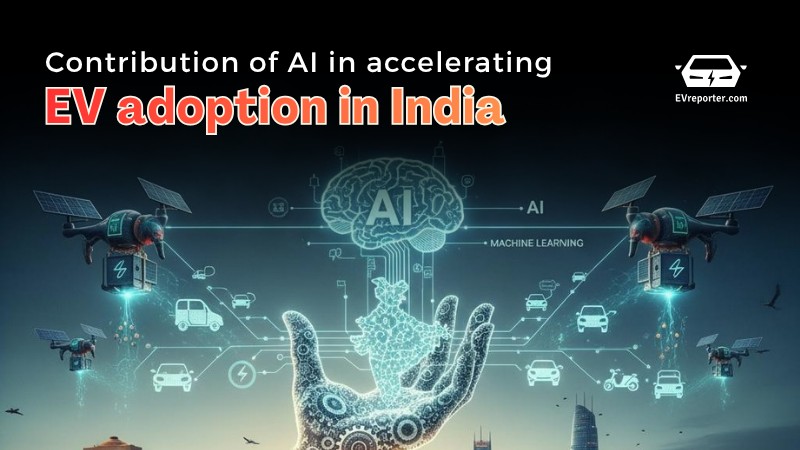Contribution and potential impact of AI with respect to rapid EV penetration in India
AI is one of the unsung accelerators of EV adoption in India. In this article, author Satyendra Pal summarises how AI is helping, its impact and practical recommendations for OEMs, fleet operators and policymakers.
Snapshot – why does this matter
- India sold ~2,037,831 electric vehicles in FY 2024–25 (all segments combined; FY24–25 EV sales ≈ 2.04 million, a ~15.7% YoY increase). EVs made up ~7.8% of total vehicle sales in FY24–25.
- Public charging infrastructure remains sparse relative to need; government and industry counts point to roughly ~12,000 public charging stations (as of early 2024). (State/ National-Highway charger counts also appear on data.gov.in / government replies).
- Strategic national analysis (NITI Aayog) frames EV as a major economic opportunity for India (multi-$100B by 2030) and separately highlights that AI adoption across sectors could add hundreds of billions to GDP by 2035 – underscoring the macro leverage of AI-enabled mobility.
How AI directly speeds up EV penetration
1) Predictive maintenance → higher uptime, lower operating cost (huge for fleets)
Where AI is used: ML (machine learning) models on telematics + sensor data predict component/battery failures and remaining useful life (RUL), so repairs are scheduled before breakdowns.
Quantified impact: Fleet studies and industry reviews report downtime reductions of 20–50% and maintenance cost reductions of 25–40% when predictive maintenance is implemented. That directly raises vehicle availability-a key barrier for fleet electrification.
2) Battery Management & Range Optimization – safer, cheaper ownership
Where AI is used: On-board Battery Management Systems (BMS) use ML to estimate State of Charge (SoC) and State of Health (SoH) more accurately, adapt charging profiles, and extend cycle life. Academic/industry reviews show AI-based energy management can improve usable range and lifecycle and reduce degradation. This reduces the total cost of ownership (TCO) and range anxiety.
3) Smart charging, grid integration and V2G — reduce infrastructure stress
Where AI is used: Schedules and controls charging across many vehicles to avoid peak loads, optimize charging cost (time-of-use/renewables), and enable vehicle-to-grid services.
Quantified impact: Smart charging / V2G studies estimate peak load reduction of ~10–20% and notable grid cost savings; Academic reviews show V2G can help reduce demand peaks and provide ancillary services. That lowers barriers for large-scale EV adoption and reduces incremental grid upgrade costs.
4) Fleet routing & utilization optimization- more effective electrification of the last-mile
Where AI is used: Route planning that accounts for traffic, charger locations and battery state increases daily km per vehicle and reduces range-related downtime. For logistics providers, this improves utilization (fewer vehicles needed to do the same work), improving capex economics for EV transition. (Industry reports highlight fleet optimization as a major driver for switching to EVs).
5) Manufacturing & quality control — scale faster, cost less
Where AI is used: Vision systems and anomaly detection on production lines raise yield, reduce rework and accelerate ramp-up of battery and vehicle manufacturing capacity — directly supporting the supply-side to meet rising EV demand. Reviews and industry articles document this effect in automotive manufacturing.
6) Consumer experience & sales – drives demand
Where AI is used: Personalized recommendations, predictive financing models, and in-vehicle intelligent assistants improve buyer experience and ease financing/servicing decisions — nudging consumers to pick EVs sooner. Industry write-ups cite the rising role of intelligent systems in buyer conversion.
Numbers & impact
- Fleet uptime / downtime: predictive maintenance → 20–50% reduction in downtime; maintenance costs ~25–40% lower in multiple studies (helps fleets meet strict SLAs).
- Grid peak reduction: smart charging / V2G → ~10–20% peak load reduction in modelled studies (reduces need for costly grid upgrades).
- National EV growth context: India’s EV sales ~2.04M FY24–25 (~ 7.8% of total auto volumes). Faster AI adoption across the economy is also projected to add hundreds of billions to GDP by 2035, showing macro upside if AI is widely applied in mobility and energy.
Indian context – where AI matters most right now
- Two-wheelers & three-wheelers (largest volumes) – AI-driven battery health and predictive servicing are low-hanging fruit (telemetry + ML).
- Commercial fleets / last-mile logistics – Biggest ROI from predictive maintenance, route optimisation, and smart charging. Operators switching entire fleets see TCO improvements that justify EV adoption.
- Charging network operators & utilities: Use AI for demand forecasting, dynamic pricing, and charger dispatch; critical as public chargers (~12k currently) scale.
Barriers / risks AI must overcome
- Data quality & interoperability: Heterogeneous telematics and BMS data across many OEMs/fleets.
- Cybersecurity & privacy: More intelligence means a larger attack surface (charging infrastructure, vehicle systems). AI-augmented anomaly detection helps, but must be implemented securely.
- Skill & investment gap: Many smaller fleets/OEM suppliers need technical help and capital to adopt AI solutions.
Practical recommendations (for policymakers, OEMs, fleets)
- Mandate open telematics/BMS standards and data APIs to accelerate AI tool development and portability.
- Incentivize smart-charging pilots and V2G (time-of-use tariffs + aggregator frameworks) to unlock grid benefits.
- Fund shared data platforms and anonymised datasets for battery health and predictive maintenance research (lowers the entry barrier for start-ups).
- Support cyber-resilience standards for charging networks and EV telematics (AI for anomaly detection + regulatory requirements).
Bottom line
AI is not just an add-on—it’s a multiplier for EV adoption in India. By improving uptime and TCO for fleets, enabling efficient charging and grid management, and helping manufacturing scale, AI tackles both demand and supply constraints. With Indian EV sales crossing ~2.0 million units in FY24–25 and infrastructure still catching up, AI-powered solutions can meaningfully accelerate penetration-and they already show quantifiable benefits (downtime cuts of 20–50%, peak load reductions ~10–20%, etc.).
About the author

Satyendra Pal
EV Mobility Enthusiast | Enabling Sustainable Transport |DGM-Sales & Marketing, Evall Mobility Ltd
Subscribe today for free and stay on top of latest developments in EV domain.





